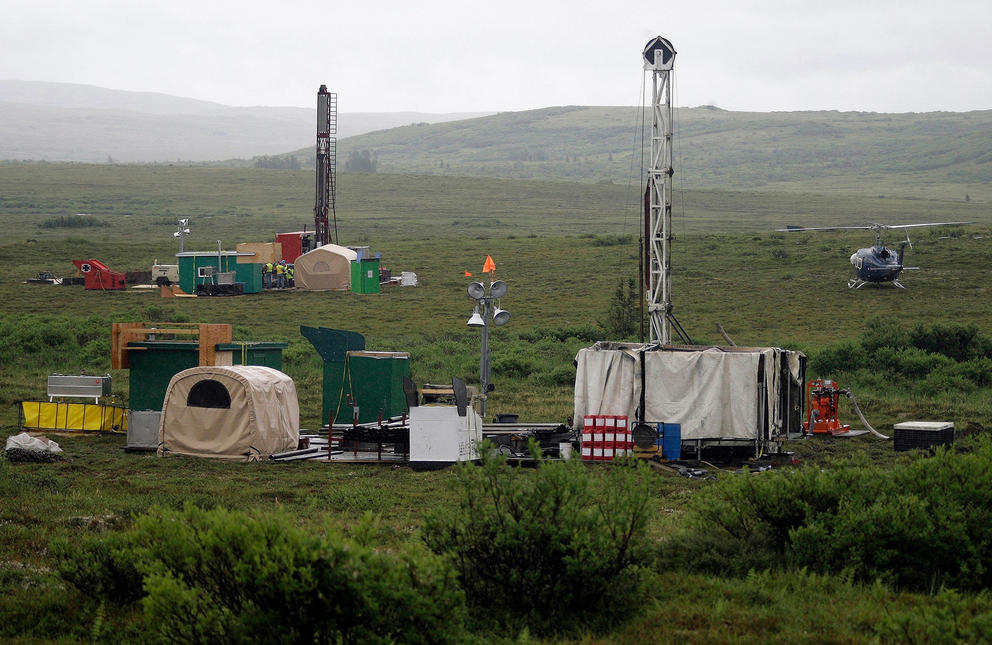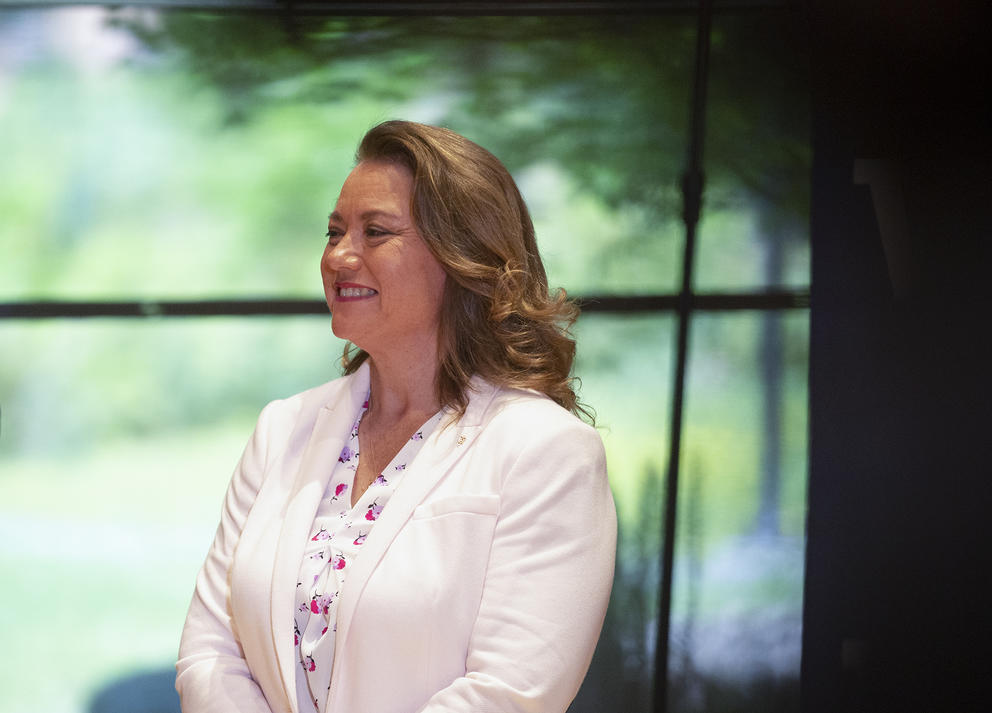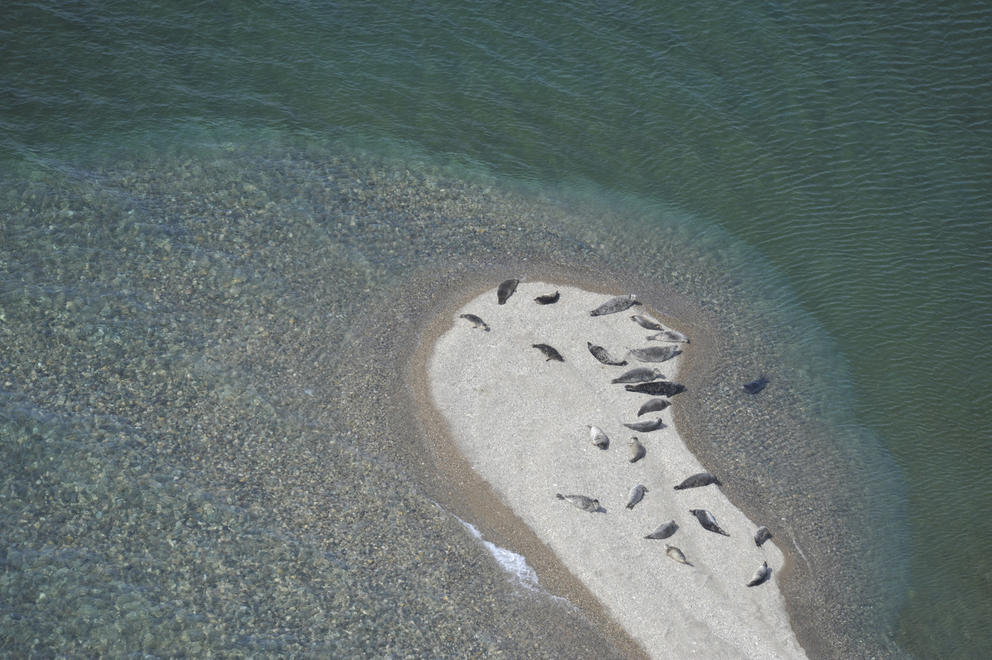The Pedro Bay Corp., an Alaska Native village corporation that manages the resources in and around the tiny village of Pedro Bay, is poised to place a swath of land four-fifths the size of Seattle out of reach of development for good. The agreement would prohibit industrial development on an important corridor for the open-pit copper and gold mine’s operations. At the same time, it has been welcomed as a win for Indigenous activists who view the 12.5-square-mile mine site and all the industrial trappings that would come with it as an existential threat to Bristol Bay’s salmon and people.
Alannah Hurley, a Yup’ik woman who grew up along the bay, is executive director of the United Tribes of Bristol Bay, a consortium of 15 tribal governments representing 80% of the region’s residents. Hurley celebrated the Pedro Bay Corp.’s decision to sell the development rights on more than 68 square miles of its land to conservation organizations.
“We were overjoyed at the news that a village corporation was taking steps to ensure that their lands were going to be protected,” she says. “But we're also still remaining extremely vigilant.”
If it is built, Pebble Mine would draw on an enormous deposit of copper and gold at the headwaters of two of Bristol Bay’s major salmon rivers. The project faces plenty of hurdles, many of which have been erected by the region’s Indigenous peoples.
One notable obstacle was left behind by the Trump administration. Last November, the U.S. Army Corps of Engineers denied a critical permit sought by the mine’s developer, Pebble Limited Partnership. The company has appealed that denial, which would prevent the project from going forward.
For Seattle’s fishing industry and the Pacific Northwest economy, the stakes are high for any development that threatens Bristol Bay’s $2.2 billion fishing industry. Washington residents hold nearly one-third of the commercial fishing permits in Bristol Bay. Many of the fishing vessels in its waters are built or maintained here. And dozens of Washington seafood businesses rely on the region’s fisheries, drawing $105.3 million a year to the state — even more than Alaska’s earnings, based on 2016 data.
As proposed, the Pebble Mine would operate for 20 years, processing 180,000 tons of material a day. The Army Corps estimates the project would affect almost 5 square miles of wetlands and 9 miles of salmon-spawning streams but concluded last year that impacts to salmon would be minimal, a point disputed by former regulators, scientists, and a 2014 Environmental Protection Agency assessment. The project would pave the way for more development once roads, a power plant and a port are built in a now largely undeveloped place.
“If it were not for the Native people who live in Bristol Bay, who rely on Bristol Bay, and who have thrived in Bristol Bay since time immemorial, this mine would have been built 12 years ago,” says Matt Newman, a Native American Rights Fund attorney based in Anchorage. “It has been a remarkable resolve of the tribes and the local people in Bristol Bay who have kept these headwaters in their natural state all the way up to today.”
The northeastern shores of Lake Iliamna, Alaska’s largest lake, are the traditional lands of the Dena’ina Athabascan people, one of the Indigenous groups represented in the Pedro Bay Corp. For them and many of the other Indigenous peoples in the region, salmon is central to their way of life. That long-standing connection is reflected in the 90% support among Pedro Bay Corp. shareholders for the recent conservation deal, which would ensure the lake’s shores will not host a two-lane, 82-mile-long gravel road and adjacent natural gas pipeline serving the Pebble Mine.
The conservation deal, brokered with the nonprofits Bristol Bay Heritage Land Trust and Washington, D.C.-based Conservation Fund, would set aside more than 68 square miles — nearly half of Pedro Bay Corp.’s lands — to protect salmon habitat and, in doing so, block the road and pipeline to a proposed port on Cook Inlet.
The threat of the mine was certainly a consideration when the Pedro Bay Corp. approached the Bristol Bay Heritage Land Trust in 2017, just as the Pebble Mine was gaining fresh momentum under the new extraction-friendly Trump administration, says Tim Troll, executive director of the land trust. At the time, the corporation and the conservation groups had just finalized a different agreement protecting more than 21 square miles of salmon and freshwater seal habitat on islands in Lake Iliamna.
But Troll says his motive for pursuing a second land deal with the Pedro Bay Corp. was primarily due to the lack of protections for Lake Iliamna salmon. The lake has been responsible for roughly 20% of Bristol Bay’s sockeye over the past two decades. The northeast corner in particular is a sockeye-producing powerhouse, and an emerging body of genetic research has revealed unique differences in these salmon, further adding to the appeal of protecting the lake and the rivers feeding it. With a potential mining road in the mix, Troll recalls, “it was certainly this aha! moment.”
The deal is still contingent on the nonprofits raising $20 million by the end of 2022 to compensate the native corporation for not developing its lands. As a corporation, the company has to balance the needs of all its Alaska Native shareholders — both those people still relying on the land for subsistence and those who may have moved away or inherited their shares. “So if this works out, hopefully, the corporation will have long-term financial stability,” Troll says.
That economic tension is very real in this region, which is sparsely populated with people but rich in wetlands and wildlife, including bear and moose. Troll acknowledges how tempting the Pebble Partnership’s proposition to bring jobs there might be. It’s also a point the company emphasizes.
“We have seen support grow in the communities closest to the project as people saw what employment from a mine could look like,” says Mike Heatwole, a spokesperson for Pebble Limited Partnership, the U.S. subsidiary of Vancouver, British Columbia-based Northern Dynasty Minerals, which hopes to develop the mine.
“The Bristol Bay region, especially the communities around Iliamna Lake, faces significant economic challenges with a high cost of living and few year-round employment opportunities,” Heatwole continues. “We have long held that Pebble could make a significant contribution to the region’s economy.” The company estimates that operating the mine will create about 850 full-time jobs, with a thousand or so more during construction.
While the land deal presents a sizable barrier for the Pebble Mine’s developers, it doesn’t spell the end for the project, as mine opponents are quick to point out.
Newman, the attorney representing United Tribes of Bristol Bay, describes the conservation push as “a big deal” that would block “a viable option to transport their minerals from the mine to a saltwater port.” But he doesn’t think the Pebble Partnership will be deterred.
“This company is nothing if not a survivor and they know how to survive despite many, many predictions over the years about their pending demise,” Newman says. “Although the announcement around the Pedro [Bay Corp.] lands is a new obstacle, to say the least, I would not go so far as to say it is a death knell.”
When asked about how the conservation easement might affect the mine’s plans, Pebble Partnership’s Heatwole does not answer directly, and instead maintains that the company’s focus is on working with the Army Corps of Engineers to secure a permit.
The Army Corps had identified the proposed road through the Pedro Bay Corp. land as the “least environmentally damaging” — and in the developers’ minds, likely cheapest — way to get mined materials to the Cook Inlet port. That route is now off the table, but, should the Pebble Partnership eventually secure permits for the project, other options remain, including two ferry routes on Lake Iliamna.
The Pedro Bay Corp. deal represents only one of the many ways Indigenous people in Bristol Bay have been working to secure lasting protections for the spawning grounds of the region’s thriving salmon populations.
Since 2009, some of the tribes later represented by United Tribes of Bristol Bay and other mine opponents have pressured the Environmental Protection Agency to essentially ban intensive mining in the Bristol Bay watershed. Shifting political winds have seen the Pebble Mine nearly scuttled by the EPA or almost permitted by the Army Corps, and legal and regulatory fights continue to grind ahead.
Hurley, the United Tribes of Bristol Bay’s executive director, contends that the path to permanent protections for the watershed should be straightforward. On July 27, her organization formally petitioned the EPA to restart a Clean Water Act protections process begun under President Barack Obama that drew a lawsuit after it was paused under President Trump. The Biden administration inherited the lawsuit, which is still active.
“Why waste your time?” she says. “Don't fight this Trump-era lawsuit.”
Late last year, a coalition of tribal organizations, businesses and environmental groups also asked Congress to pass legislation that would protect the Bristol Bay watershed for salmon. More than 200 businesses and industry associations, including several from Washington state and Oregon, sent a letter in June to Biden and Congress arguing for that approach.
The request may have a receptive audience in Alaska’s U.S. senators. Both Republicans have spoken out against the mine, and Sen. Lisa Murkowski has been meeting with community leaders and fishermen this summer to look at ways of protecting the region against development.
Fishing industry leaders are pushing for a different approach to keep mining out of Bristol Bay, says David Harsila, president of the Bristol Bay Fishermen’s Association, a Seattle-based nonprofit funded by the region’s fishermen to advocate for salmon. The group is gearing up to lobby Congress to pass a law to assess the value of all existing mining permits in the region, which aren’t limited to the Pebble Partnership’s, and then to buy them out. Harsila reasons that this method would ensure that the threat of mining, whether from the Pebble Mine or others, is completely removed from the watershed.
Ultimately, Bristol Bay fishermen and tribes both want long-standing and watershed-wide protections for salmon.
“Bristol Bay's Indigenous people and Indigenous leadership … have never relented in our quest for permanent protection,” Hurley says. And they have received additional support from tribes in Washington, British Columbia and elsewhere.
Fawn Sharp, vice president of the Quinault Indian Nation and president of the National Congress of American Indians, is among them. She has called on the federal government to protect wild salmon and respect tribal sovereignty.
“It's critically important for all of us anytime there's an attempt in any way to desecrate and destroy salmon spawning habitat,” Sharp says of her decision to support Bristol Bay tribes. Tribes like hers have aggressively opposed the mine and sought safeguards for salmon wherever possible, Sharp continues.
While major decisions on the mine remain pending from the Biden administration, the Pedro Bay Corp.’s conservation deal serves as a tangible and immediate barrier to the Pebble Mine’s prospects. So far, backers of the conservation initiative have raised about one-third of the $20 million needed to buy the village corporation’s development rights, and are now looking for donors beyond Alaska.
“They've been opposing Pebble for a long time,” says Brad Meiklejohn of the Conservation Fund, the national environmental organization backing the land deal with the Pedro Bay Corp. “And we think it's time for them to get paid for that.”
CORRECTION: United Tribes of Bristol Bay's involvement in early efforts to block the Pebble Mine has been clarified.





